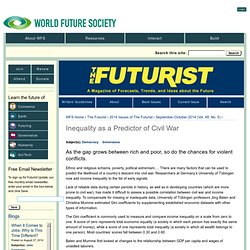

Inequality as a Predictor of Civil War. Ethnic and religious schisms, poverty, political extremism….

There are many factors that can be used to predict the likelihood of a country’s descent into civil war. Researchers at Germany’s University of Tübingen now add income inequality to the list of early signals. Lack of reliable data during certain periods in history, as well as in developing countries (which are more prone to civil war), has made it difficult to assess a possible correlation between civil war and income inequality. To compensate for missing or inadequate data, University of Tübingen professors Jörg Baten and Christina Mumme estimated Gini coefficients by supplementing established economic datasets with other types of information.
The Gini coefficient is commonly used to measure and compare income inequality on a scale from zero to one. Baten and Mumme first looked at changes to the relationship between GDP per capita and wages of unskilled laborers. Source: University of Tübingen, www.uni-tuebingen.de. Asia's middle class. Poor countries typically have a tiny rich elite, large impoverished masses, and a very small "middle class".

When development succeeds, society's middle class expands as ... Poor countries typically have a tiny rich elite, large impoverished masses, and a very small "middle class". When development succeeds, society's middle class expands as poor people escape poverty, and also as some of the elite may lose their privileged positions. As the Asian Development Bank reports, emerging Asia's middle class has increased dramatically over the past couple of decades. 35257b34-b160-45e4-980d-8bca327db92b.pdf. Asia’s Middle Class Not All About the Bling, Survey Says - Southeast Asia Real Time.
An emerging middle class. In 2009 the middle class included 1.8 billion people, with Europe (664 million), Asia (525 million) North America (338 million) accounting for the highest number of people belonging to this group.

Even in Africa, where middle class’s growth has not been very robust, it has nonetheless been noticeable and contributed to increased domestic consumption in many countries. Sales of refrigerators, television sets, mobile phones, motors and automobiles have surged in virtually every African country in recent years. Possession of cars and motor cycles in Ghana, for example, has increased by 81% since 2006.
This expansion continues. The size of the “global middle class” will increase from 1.8 billion in 2009 to 3.2 billion by 2020 and 4.9 billion by 2030. The developing world’s “emerging middle class” is a critical economic and social actor because of its potential as an engine of growth, particularly in the largest developing countries such as China and India but also in sub-Saharan Africa. The rise of Asia’s middle class - Forum:Blog Forum:Blog. The explosion of Asia’s middle class is stunning.

The size of this group currently stands at 500 million and will mushroom to 1.75 billion by 2020 – more than a threefold increase in just seven years. The world has never seen anything like this before. And it’s little wonder that people all across Asia expect a bright future for their children – according to Pew data, a massive 82% of Chinese respondents expect today’s children to grow up to be better off financially than their parents. The reason for this is that these Asian societies have begun to implement important reforms: free-market economics; mastery of science and technology; a culture of pragmatism; meritocracy; a culture of peace; the rule of law; plus, of course, education. We are seeing a tremendous rise in living standards across Asia, with poverty disappearing everywhere you look. One positive outcome of these changes, for example, is the reduction of conflict within the region.
It’s not all good news, though. Middle class growth in emerging markets. Since 1800 the world has seen two great middle class expansions, and we are living through a third.

The nineteenth century industrial revolution created a substantial Western European and American middle class, which grew again after the Second World War – a spurt which this time included Japan. Today this is happening in the emerging markets (EMs). In Asia alone, 525 million people can already count themselves middle class — more than the European Union’s total population.
Over the next two decades, the middle class is expected to expand by another three billion, coming almost exclusively from the emerging world. This paper looks at this growth and how it will change both developing and developed worlds. By 2030, so many people will have escaped poverty that the balance of geopolitical power will have changed completely, and global trade patterns will also be unrecognizable. Next.